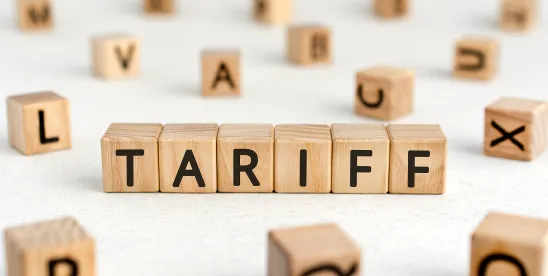President Trump announced new tariffs on April 2, 2025, which he referred to as “reciprocal tariffs,” on almost all imports into the United States. The tariff package will be rolled out in two phases. Tariffs of 10 percent were imposed on all countries as of April 5. On April 9, additional, higher tariffs will be imposed on 57 countries, including the European Union, with which the United States has determined it has the largest trade deficits.
What Are the “Reciprocal Tariffs?”
According to a paper issued by the U.S. Trade Representative, the reciprocal tariffs “are calculated as the tariff rate necessary to balance bilateral trade deficits between the United States and our trading partners.” President Trump decided to impose only half of the rates calculated under that formula, while applying a minimum rate of 10 percent. Country-specific tariff rates span a range from the highest at 50 percent for Lesotho to the lowest at 11 percent for Cameroon and the Democratic Republic of the Congo. The tariffs apply only to the non-U.S. content of an import, provided at least 20 percent of the import’s value is U.S. originating. Importers claiming partial exemption for U.S. content may be subject to rigorous auditing requirements.
President Trump enacted the new tariff package under the authority of the International Emergency Economic Powers Act (“IEEPA”). The national emergency that the reciprocal tariffs are intended to address is the threat posed by the trade deficit and “other harmful policies like currency manipulation” that undermine the “national security and economy of the United States.” The President has previously used the IEEPA to impose tariffs on China, Canada, and Mexico to address illegal migration and imports of fentanyl into the United States
The current list of country specific tariff rates, as set out in Annex I of the Executive Order (“EO”), is below:

As President Trump instructed in his January 20 America First Trade Policy Memorandum, the Commerce Department, the Treasury Department, and the U.S. Trade Representative delivered a Report to the President on April 1 covering a wide range of trade issues, including, among others, reviews of steel and aluminum tariff exclusions, investigations on copper and lumber imports, assessments of U.S. trade agreements, and a review of the “de minimis” tariff exemptions for low-value shipments. On February 13, the President directed further review of “non-reciprocal trading practices.” In addition to providing the basis for the April 2 EO, this Report will likely influence the imposition of further tariffs, especially in the ongoing national security investigations on copper and lumber.
The Interaction of the Reciprocal Tariffs with Additional New Tariffs
In a separate but related action, so-called “secondary tariffs” of 25 percent may soon be imposed on imports from any country that the Commerce Department determines is importing oil from Venezuela. It is widely expected that China will be among the countries designated by Commerce. These tariffs will be in addition to all other tariffs already being imposed.
Finally, President Trump signed an EO on April 2 ending de minimis treatment on imports from China beginning May 2. Imports valued at $800 or less have until now been exempt from any tariffs. After that date, these imports will be subject to a duty of either 30 percent or $25 per item, increasing to $50 after June 1. This is in addition to all other tariffs and duties imposed on China thus far.
Are Any Goods Excluded from the Reciprocal Tariffs?
The EO confirmed that imports from Canada and Mexico, currently subject to 25 percent tariffs (10 percent for energy and potash) to address fentanyl and immigration border security issues will not be subject to reciprocal tariffs. However, goods that comply with the United States-Mexico-Canada Agreement (“USMCA”) preferential origin rules were and will continue to be exempted from the 25 percent and 10 percent fentanyl/migration tariffs. Should the President terminate the fentanyl/migration orders, Canadian and Mexican goods (with the exception of energy and potash) that are not compliant with the USMCA rules of origin will become subject to a 12 percent rate.
Another class of imports that will not be subject to the April 2 tariffs are items that are subject to the 25 percent tariffs that have previously been imposed under section 232 (an action that that allows the President to adjust imports if they are deemed to threaten national security) against a targeted range of goods, including aluminum, steel, and automobiles and their parts. Products that are currently subject to section 232 investigations, such as lumber and copper, and products that are expected to be investigated such as pharmaceuticals and semiconductors, are also excluded. Bullion, energy, and other certain minerals that are not available in the United States, as well as all other products enumerated in Annex II, are exempt.
Click here for President Trump’s reciprocal tariff EO (which includes Annexes I and II as in-text hyperlinks), and here for the accompanying fact sheet. Click here for President Trump’s April 2 amendment to the de minimis EO on China. Click here for the report to the president from Commerce, Treasury, and the United States Trade Representative.







 />i
/>i

